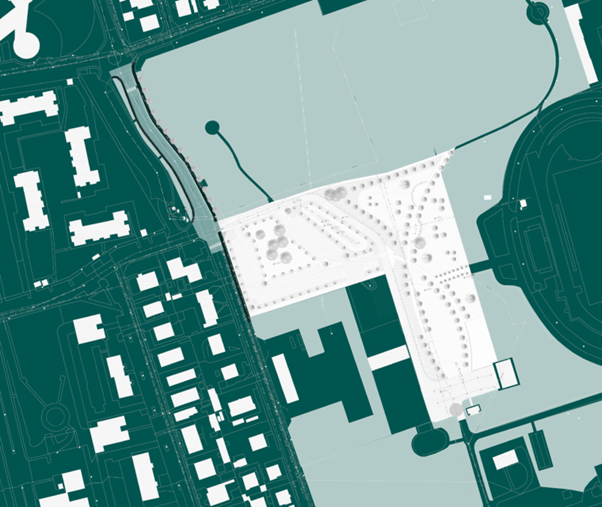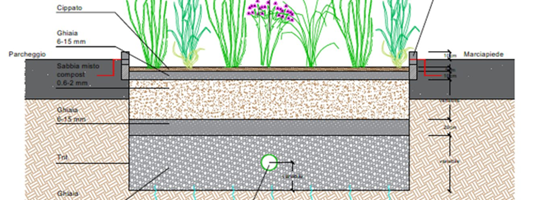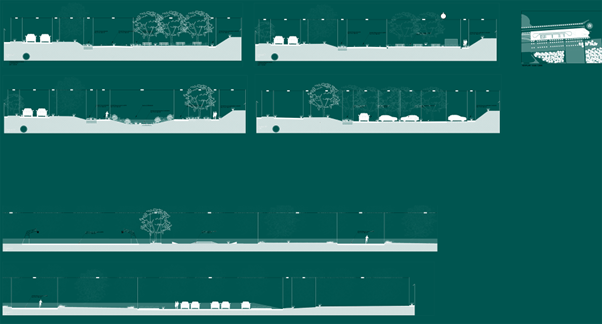UTA is participating in the Horizon Europe project “MICAD” and is active in analysing the digital and climate transition plans of the partner cities of the project.
This article presents one of the interesting activities of the Metropolitan City of Milan that was highlighted as an example of their climate transition plan.
Climate change is reshaping the way cities must think about water. More frequent cloudbursts, flash floods, and long droughts put pressure on urban systems that were never designed for such extremes. Traditional stormwater management relies on underground pipes and fast drainage, but this approach often leads to flooded streets, overwhelmed treatment plants, and the loss of a resource that could be vital during dry periods.
A growing number of cities are adopting a new model: the Sponge City. This approach manages rainwater where it falls, allowing it to infiltrate, evaporate, or be stored locally. It combines Nature-Based Solutions (NBS) and Sustainable Urban Drainage Systems (SuDS) to mimic natural processes in highly urbanised settings.
(Images: https://jpius.it/)

Milan’s Sponge City Programme
The Metropolitan City of Milan has launched one of the most ambitious Sponge City initiatives in Europe. Known as the PUI CMM Spugna programme, it introduces innovative water management and urban regeneration solutions across the metropolitan area.
Key figures:
- 90 interventions in 32 municipalities
- Target areas include car parks, public squares, roads, and green spaces
- Works focus on de-impermeabilisation and ecological renewal
- 48 sites completed, 14 ongoing, 28 planned (as of May 2025)
Solutions applied include:
- Rain gardens and bio-retention areas
- Permeable pavements
- Vegetated swales and drainage channels
- Detention basins and wetlands
- Infiltration and drainage trenches
- Tree pits and subsurface retention systems
- Storage tanks and cisterns
Some interventions combine resilience with community use. In Cinisello Balsamo, a degraded site was transformed into a multi-sport complex with basketball courts, athletic tracks, and a skate park. In Cologno Monzese, a floodable square now reduces flood risk while offering residents a vibrant public space.
How a Sponge city works

Unlike conventional drainage systems, which move water away as quickly as possible, Sponge City infrastructure slows, stores, and filters rainwater. SuDS allow water to seep into the soil, recharge groundwater, and be released gradually, preventing flood peaks. They also filter pollutants, improve air quality, and reduce the urban heat island effect.
This makes Sponge Cities multi-functional: the same intervention can provide hydraulic safety, biodiversity support, climate adaptation, and social value all at once.
Why this matters beyond Milan
Milan’s initiative is part of the MICAD Horizon Europe project, which studies how cities can combine digital and climate transition. For other metropolitan areas in Europe and beyond, the PUI CMM Spugna is a scalable model:
- Policy integration: Combining climate adaptation, biodiversity, and public realm improvement attracts wider funding.
- Community engagement: Projects that double as parks, squares, or sport facilities generate local support.
- Transferability: Even small interventions, like permeable pavements or rain gardens, can demonstrate tangible benefits.
- Systemic resilience: Distributing interventions across the territory reduces vulnerability at both micro- and metropolitan scale.
A European learning example
The Sponge City model is already proving successful in Rotterdam (More Information), Copenhagen (More information) , and now Milan (More Information). By retaining and reusing rainwater locally, cities can adapt to climate extremes while creating more liveable, healthier, and greener environments.
Milan’s experience offers a concrete reference point on how to move from strategy to implementation — and how to combine climate resilience with urban regeneration.
Further reading and examples:
